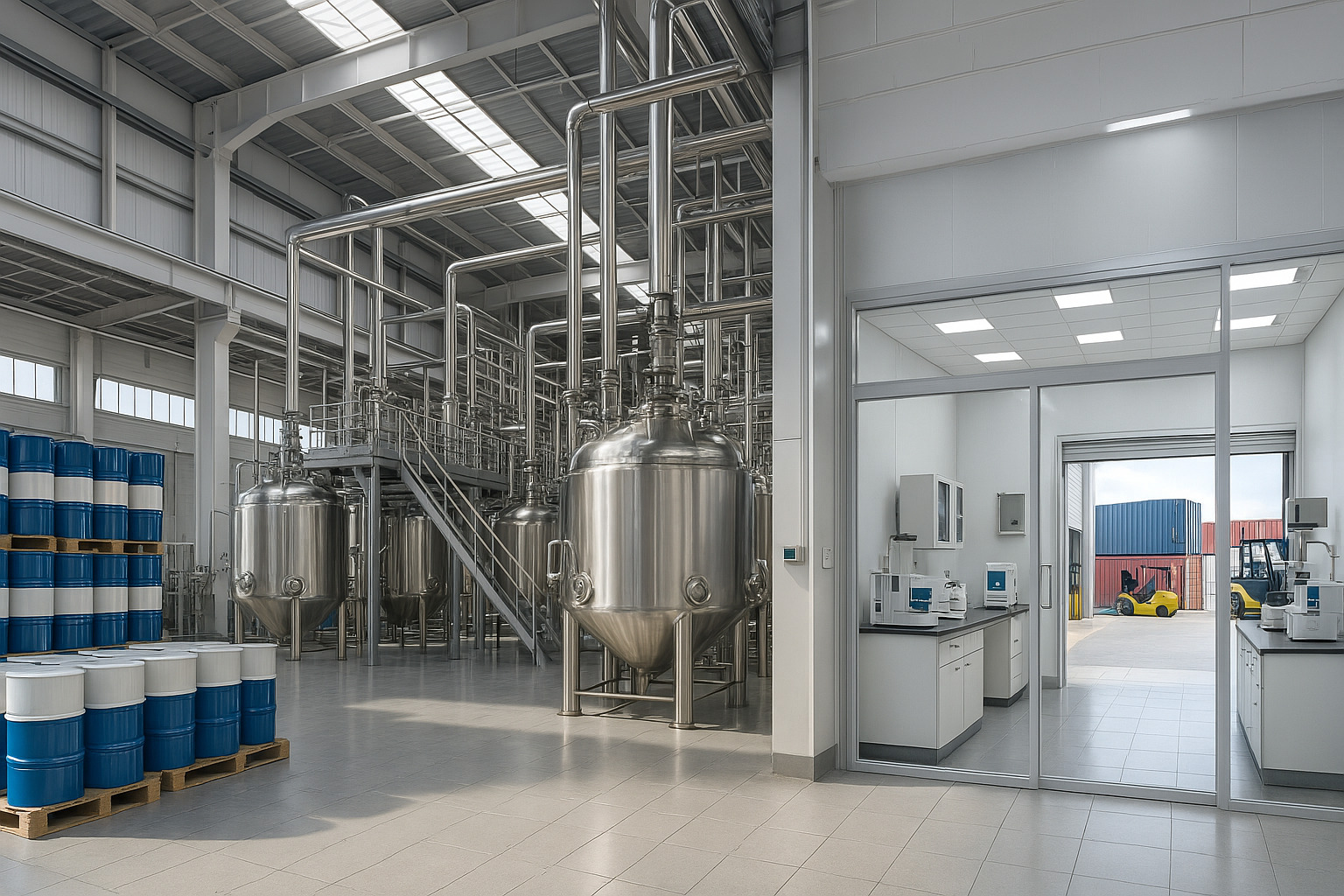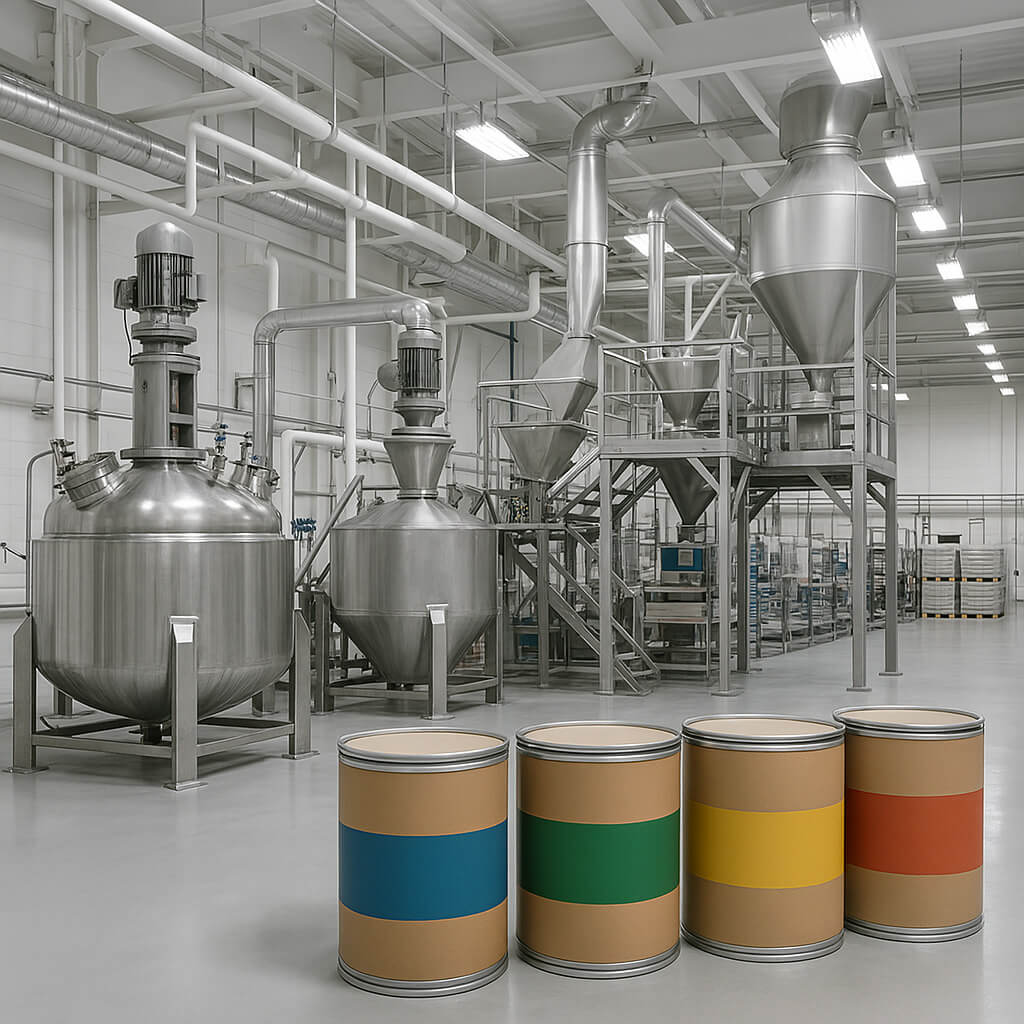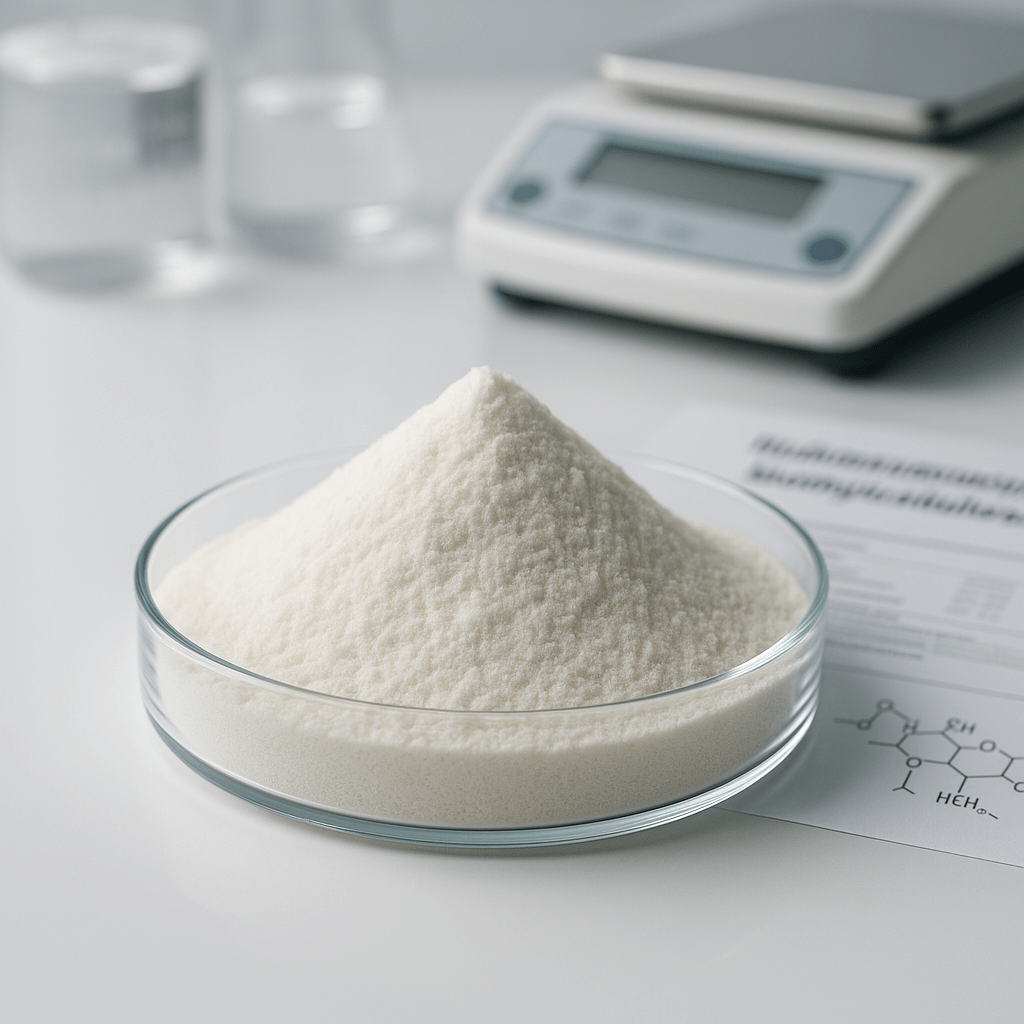Raw material shortages and production disruptions can threaten your construction project timelines or manufacturing schedules without warning.
Stable HPMC supply chains depend on multiple interconnected factors including reliable raw materials, consistent manufacturing capabilities, effective logistics management, and transparent supplier relationships to maintain predictable delivery and quality.

The image shows HPMC supply chain elements including raw material storage, manufacturing facility, quality testing, and global shipping containers.
Ensuring your business has uninterrupted access to quality HPMC requires understanding these critical factors. Let’s explore what truly determines supply chain reliability in today’s challenging market.
What are the key raw material risks in HPMC production?
Unexpected raw material shortages can halt production completely, leaving your operation stranded without essential HPMC supplies.
Raw material stability for HPMC production depends primarily on cellulose pulp availability, propylene oxide supply consistency, and methyl chloride sourcing. These core components directly impact production capacity and delivery schedules.
We’ve witnessed significant raw material challenges over our decade in HPMC manufacturing. Cotton linter pulp, our primary cellulose source, faces seasonal price fluctuations of 15-30% annually. According to industry reports from Cellulose Derivatives Market Analysis, global pulp shortages can extend lead times by 3-6 weeks during peak seasons. Supply disruptions often stem from agricultural variations in cotton harvests, with weather patterns affecting both quantity and quality.
The chemical precursors present different challenges. Propylene oxide and methyl chloride, both petroleum derivatives, fluctuate with oil markets. When petroleum prices spiked 40% in 2022, these raw materials saw similar increases, compressing margins across the industry. The regulatory environment also impacts availability, with chemical transportation restrictions constantly evolving across different regions.
Our approach focuses on multi-source procurement strategies. We maintain relationships with suppliers across three continents, allowing us to pivot when regional shortages occur. This redundancy has proven valuable during recent supply chain disruptions, enabling us to maintain 92% on-time delivery despite industry-wide challenges.
How do manufacturing capabilities impact consistency and lead time?
Production equipment breakdowns or capacity limitations can mean months of delays when demand surges unexpectedly.
Manufacturing capability directly affects HPMC quality consistency and delivery reliability through production capacity, equipment sophistication, and technical expertise levels within the operation.
At our 30,000-ton capacity facility, we’ve invested heavily in automated production lines with real-time monitoring systems. This technology maintains viscosity tolerances within ±3% across batches, unlike manual systems that typically vary by 8-12%. The International Pharmaceutical Excipients Council standards recommend equipment precision controls to ensure consistent substitution levels across production runs.
Temperature control systems prove especially critical during etheration reactions. Our facilities maintain ±1°C precision throughout the process, preventing unwanted side reactions that can alter final product properties. Most smaller operations can only achieve ±3-5°C control, resulting in batch-to-batch variations that challenge formulators.
Technical staff expertise represents another crucial factor. Our 160-person team includes 12 PhD chemists specializing in cellulose chemistry, allowing us to troubleshoot complex production challenges quickly. This expertise becomes particularly valuable when processing specialized grades with tight performance parameters.
Production capacity flexibility determines how manufacturers handle demand fluctuations. We maintain 15-20% reserve capacity during normal operations, allowing us to accommodate urgent orders without disrupting established supply chains. This buffer helped us maintain service levels during the 35% demand surge experienced in 2023 when construction markets rebounded unexpectedly.
Production Scale and Quality Correlation
| Production Scale | Quality Control Precision | Typical Lead Time | Batch Consistency |
|---|---|---|---|
| Small-scale (<5,000 tons) | Manual testing, limited QC | 4-6 weeks | Moderate variation |
| Mid-scale (5,000-20,000 tons) | Semi-automated testing | 3-4 weeks | Good consistency |
| Large-scale (>20,000 tons) | Fully automated inline testing | 2-3 weeks | Excellent consistency |
Through experience, we’ve found that manufacturing scale correlates strongly with both consistency and responsiveness. Manufacturers with larger facilities typically maintain more sophisticated quality systems and can absorb demand fluctuations more effectively.
What role does logistics play in supply chain reliability?
Shipping delays and mishandled cargo can transform on-schedule production into costly project interruptions without adequate logistics planning.
Logistics reliability affects HPMC supply chains through transportation partner selection, shipping route optimization, and customs clearance efficiency that together determine whether deliveries arrive intact and on schedule.
The logistics landscape has transformed dramatically in recent years. Ocean freight reliability dropped from 78% on-time performance to below 40% during peak disruptions, according to Sea-Intelligence Global Liner Performance reports. For moisture-sensitive products like HPMC, these delays increased exposure risks and quality concerns.
We’ve developed specialized handling protocols to protect product integrity throughout the shipping process. HPMC requires precise humidity control during transportation to prevent agglomeration. Our standard packaging includes multi-layer moisture barrier bags with silica desiccant packets, maintaining internal relative humidity below 40% regardless of external conditions.
Container selection proves equally important. We exclusively use food-grade containers for pharmaceutical-grade HPMC to prevent cross-contamination risks. These specialized containers reduce contamination claims by approximately 95% compared to standard shipping methods. For construction-grade products, premium containers still prevent moisture ingress while optimizing shipping costs.
Documentation efficiency significantly impacts customs clearance times. We maintain electronic documentation systems with pre-verification protocols for major destinations. This approach reduces average customs processing from 7-10 days to 2-3 days for most shipments to North America and Europe. Working with specialized chemical logistics partners like DHL Global Forwarding further streamlines the process through their established customs relationships.
Our logistics strategy emphasizes redundancy across shipping lanes. By maintaining relationships with multiple freight forwarders and using diverse shipping routes, we’ve achieved 94% on-time delivery performance even during recent supply chain disruptions.
How does global demand fluctuation influence the HPMC supply chain?
Market demand shifts can quickly transform abundant supply into critical shortages, leaving unprepared buyers scrambling for materials.
Global demand patterns impact HPMC availability through seasonal construction cycles, pharmaceutical project pipelines, and emerging market growth that collectively create predictable yet challenging supply-demand imbalances.
Construction industry cycles drive significant demand fluctuations. In North America and Europe, construction activity typically increases 40-60% during spring and summer months, creating corresponding HPMC demand spikes. This pattern repeats annually, yet many buyers still place orders reactively rather than planning inventory around these cycles.
The pharmaceutical sector follows different patterns tied to regulatory approval timelines and production schedules. According to PharmTech industry analysis, drug manufacturers typically increase HPMC procurement 4-6 months before scheduled production runs. These concentrated buying periods can temporarily strain supply for certain specialized grades.
Emerging markets present both opportunities and challenges. Regions like Southeast Asia and parts of Africa have shown HPMC demand growth exceeding 12% annually over the past five years, compared to 3-5% in established markets. This rapid expansion periodically creates supply imbalances as manufacturers adjust production capacity.
We’ve learned to track leading indicators that anticipate demand shifts. Building permit data from major markets typically provides 3-4 month advance notice of construction-related demand changes. Similarly, pharmaceutical pipeline monitoring helps anticipate specialized grade requirements. This intelligence allows production planning to align with market needs.
Our factory maintains strategic inventory levels for major grades, typically 4-6 weeks of finished goods based on rolling demand forecasts. This buffer absorbs short-term demand fluctuations without impacting lead times for regular customers.
Why is supplier transparency critical for long-term stability?
Working with opaque suppliers often means discovering problems only after production stops or quality issues emerge in your finished products.
Supplier transparency affects supply chain stability through quality documentation practices, production capacity disclosure, and proactive communication about challenges that together build predictable business relationships.
Quality transparency provides critical assurance. We share complete batch testing reports covering all specification parameters, unlike many suppliers who provide only pass/fail certificates. This approach aligns with International Pharmaceutical Excipients Council guidelines for comprehensive documentation. Customers receive detailed viscosity curves, substitution level analysis, and particle size distribution data for every shipment.
Production capacity transparency helps customers understand true lead time constraints. We publish current capacity utilization figures monthly, allowing procurement teams to anticipate potential delays before they occur. When operating above 85% capacity, we proactively notify customers about possible extended lead times.
Communication frameworks determine how effectively suppliers handle disruptions. Our structured escalation system includes automatic notifications for any deviation from confirmed delivery dates, with designated contacts at multiple levels to address concerns. This contrasts with industry norms where customers often learn about delays only after expected delivery dates have passed.
Financial transparency also impacts long-term stability. We share our risk management practices regarding raw material costs and currency fluctuations, helping customers understand potential pricing pressures before they affect contracts. This openness allows collaborative approaches to managing volatility.
Through transparency, we’ve maintained 97% customer retention over five years, significantly above industry averages. The predictability this creates benefits both our operation and our customers’ planning processes.
How do price volatility and contract terms affect B2B procurement?
Price spikes and unclear contract terms can destroy budgets and disrupt production without warning when suppliers hold all the negotiating power.
Contract structures influence HPMC procurement stability through pricing models, volume commitment frameworks, and force majeure provisions that determine how risk is shared between suppliers and buyers.
Fixed-price contracts traditionally dominated the industry, but recent volatility has shifted practices. Many suppliers now implement raw material indexing clauses that adjust pricing based on key input costs. According to Chemical Week market reports, nearly 65% of specialty chemical contracts now include some form of raw material indexing, compared to less than 30% five years ago.
Volume commitments create stability for both parties. Our standard agreements include tiered pricing with minimum volume requirements, providing customers 5-12% cost advantages while giving our production team predictable base loading. These arrangements typically cover 60-70% of customer requirements, leaving flexibility for demand fluctuations.
Force majeure provisions have gained renewed attention following recent supply chain disruptions. Standard industry clauses often provide broad supplier protections without corresponding customer remedies. We’ve developed balanced approaches that include alternative sourcing rights for customers during extended force majeure periods.
Payment terms significantly impact cash flow across the supply chain. Standard industry terms range from 30-60 days, but we’ve implemented early payment incentives that provide 1.5-2% discounts for payments within 15 days. Approximately 30% of customers utilize these programs, improving cash cycle efficiency for both parties.
Long-term partnership agreements provide the greatest stability. These typically span 2-3 years with annual review mechanisms, creating frameworks for collaborative problem-solving during market disruptions. Partners receive priority allocation during supply constraints, ensuring business continuity during challenging periods.
FAQs
How does temperature affect HPMC stability?
Temperature impacts HPMC through two primary mechanisms – dissolution behavior and long-term stability. Above 85°C, HPMC exhibits inverse solubility, precipitating out of solution rather than dissolving. For storage, HPMC remains stable between 5-35°C, but extended exposure above 40°C can cause thermal degradation, reducing viscosity performance by 5-15%.
What are the key properties of HPMC for supply chains?
HPMC’s hygroscopic nature makes it moisture-sensitive during transportation and storage. Important properties include particle size (typically 100-125 μm), bulk density (0.3-0.7 g/cm³), and moisture content (typically maintained below 5%). These characteristics affect flow properties, packaging requirements, and handling procedures throughout the supply chain.
What are the recommended storage conditions for HPMC?
Optimal HPMC storage requires cool, dry conditions below 30°C and relative humidity under 65%. Containers should remain tightly sealed to prevent moisture absorption. For long-term storage exceeding six months, climate-controlled warehousing with temperature monitoring is recommended. These conditions prevent caking, viscosity loss, and microbial contamination risks.
What causes thermal degradation of HPMC during transportation?
Thermal degradation in HPMC occurs when temperatures exceed 40°C for extended periods, breaking polymer chains and reducing molecular weight. This happens most commonly in shipping containers exposed to direct sunlight in hot climates or during extended warehouse storage in non-climate-controlled facilities. Degradation manifests as yellowing and decreased viscosity in the final product.
Conclusion
Establishing a stable HPMC supply chain requires understanding and managing multiple interconnected factors. Raw material sourcing, manufacturing capabilities, logistics infrastructure, demand patterns, supplier transparency, and contract structures all contribute to overall stability. We’ve learned through experience that proactive management of these elements significantly reduces supply disruptions.
Building resilient supply chains involves strategic supplier selection based on more than just price. Look for partners with robust raw material strategies, sufficient manufacturing capacity, strong logistics capabilities, and transparent business practices. These characteristics indicate a supplier’s ability to maintain consistency even during challenging market conditions.
Contact Morton today for a consultation on optimizing your HPMC supply chain. Our technical team can evaluate your specific requirements and recommend approaches to enhance reliability while maintaining quality standards.




